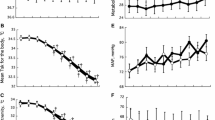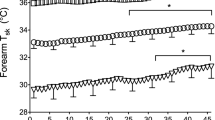Abstract
Ten older (aged 64–76 years) and ten younger (aged 20–24 years) healthy men were exposed to a standard heat stress [by placing the lower legs and feet in a water bath at 42°C while sitting in a controlled environment (ambient temperature 35°C and 45 % relative humidity) for 60 min]. During passive heating, the rectal temperature of the older men was significantly greater (P < 0.05) and mean skin temperature was lower (P < 0.001), compared to the younger men. Skin blood flow by laser Doppler flowmetry (LDF) was significantly lower on the chest and thigh for the older men (P < 0.001), but forehead LDF did not differ between the groups. The percentages of total LDF in the older men to total LDF in the younger men for the last 30 min were 99%, 58% and 50% on the forehead, chest and thigh, respectively. The age-related differences in LDF responses mirrored cutaneous vascular conductances (CVC), since no group and time effects were observed in mean arterial blood pressure during the test. During the last 30 min the local sweat rates (msw) on the back and thigh were significantly lower for the older men (P < 0.02), but not on forehead, chest and forearm, although the older men had lower msw during the first 30 min exposure regardless of site (P < 0.03). The percentages of total msw in the older men to total msw in the younger men during the last 30 min were 105%, 99%, 63%, 106% and 88% on the forehead, chest, thigh, forearm, and back, respectively. During the latter half of the exposure, the older men had similar LDF, CVC and msw on the forehead, lower LDF and CVC and a similar msw on the chest, and lower LDF, CVC and msw on the thigh, compared to the younger men. These results suggest firstly that regional differences exist in the age-related decrement of cutaneous vasodilatation as well as sweat gland function, secondly that the age-related decrement in cutaneous vascular function may precede a decrement in sweat gland function, and thirdly that the successive decrements may develop sequentially from the lower limbs to the upper body, and head.
Similar content being viewed by others
References
Amery A, Bossart H, Verstraete M (1969) Muscle blood flow in normal and hypertensive subjects: influence of age, exercise and body position. Am Heart J 78:211–215
Anderson RK, Kenney WL (1987) Effect of age on heat-activated sweat gland density and flow during exercise in dry heat. J Appl Physiol 63:1089–1094
Aoki K, Shiojiri T, Shibasaki M, Takano S, Kondo N, Iwata A (1995) The effect of diurnal variation on the regional differences in sweating and skin blood flow during exercise. Eur J Appl Physiol 71:276–280
Cowburn EJ, Fox RH (1974) A technique for studying thermal perception. J Physiol (Lond) 239:77–78
Evans E, Rendell M, Bartek J, Connor S, Bamisedun O, Dovgan D, Gitter M (1993) Thermally-induced cutaneous vasodilatation in aging. J Gerontol 48:M53–57
Falk B, Bar-Or O, Smolander J, Frost G (1994) Response to rest and exercise in the cold: effects of age and aerobic fitness. J Appl Physiol 76:72–78
Fujimoto S, Watanabe T (1969) Studies on the body surface area of Japanese Acta Med Nagasaki 13:1–13
Hardy RF, DuBois EF (1937) Regulation of heat loss from the human body. Proc Natl Acad Sci (Washington) 23:624–631
Havenith G, Inoue Y, Luttikholt V, Kenney WL (1995) Age predicts cardiovascular, but not thermoregulatory, responses to humid heat stress. Fur J Appl Physiol 70:88–96
Hellon RF, Lind AR (1956) Observations on the activity of sweat glands with special reference to the influence of aging. J Physiol (Lond) 133:132–144
Hirata K, Yutani M, Nagasaka M (1993) Increased hand blood limits other skin vasodilation. J Therm Biol 18:325–327
Inoue Y (1996) Longitudinal effects of age on heat-activated sweat gland density and output in healthy active older men. Eur J Appl Physiol 74:72–77
Inoue Y, Nakao M, Araki T, Murakami H (1991) Regional differences in the sweating responses of older and younger men. J Appl Physiol 71:2453–2459
Inoue Y, Nakao M, Araki T, Ueda H (1992) Thermoregulatory responses of young and older men to cold exposure. Eur J Appl Physiol 65:492–498
Inoue Y, Ueda H, Nakao M, Araki T (1994) The relative influences of anthropometric measures, aerobic fitness, pedometer readings and microclimate temperatures in daily life on heat and cold responses of older men (in Japanese). Jpn J Biometeor 31:189–199
Inoue Y, Nakao M, Okudaira S, Ueda H, Araki T (1995a) Seasonal variation in sweating responses of older and younger men. Eur J Appl Physiol 70:6–12
Inoue Y, Nakao M, Ueda H, Araki T (1995b) Seasonal variation in physiological responses to mild cold air in young and older men. Int J Biometeorol 38:131–136
Johnson JM, Taylor WF, Shepherd AP, Park MK (1984) Laser-Doppler measurement of skin blood flow: comparison with plethysmography. J Appl Physiol 56:798–803
Kenney WL (1988) Control of heat-induced cutaneous vasodilatation in relation to age. Eur J Appl Physiol 57:120–125
Kenney WL, Fowler SR (1988) Methylcholine-activated eccrine sweat gland density and output as a function of age. J Appl Physiol 65:1082–1086
Kenney WL, Tankersley CG, Newswanger DL, Hyde DE, Puhl SM, Turner NL (1990) Age and hypohydration independently influence the peripheral vascular response to heat stress. J Appl Physiol 68:1902–1908
Kuchar O, Kuba J, Tomsu M (1972) Messung der Muskeldurchblutung in den unteren Extremitaeten nach der lokalen xenon-133 clearance Methode: I Normalwerte und ihre Abhaengigkeit vom Lebensalter. Radiobiol Radiother (Berl) 13:217–224
Love AHG, Shanks RG (1962) The relationship between the onset of sweating and vasodilatation in the forearm during body heating. J Physiol (Lond) 162:121–128
Lundberg JM, Anggard A, Fahrenkrug J, Hokfelt T, Mutt V (1980) Vasoactive intestinal polypeptide in cholinergic neurons of exocrine gland: functional significance of coexisting transmitters for vasodilatation and secretion. Proc Natl Acad Sci USA 77:1651–1655
O'Hanlon JF, Horvath SM (1970) Changing physiological relationships in men under acute cold stress. Can J Physiol Pharmacol 48:1–10
Patterson MJ, Warlters D, Taylor NAS (1994) Attenuation of the cutaneous blood flow responses during combined exercise and heat stress. Eur J Appl Physiol 69:367–369
Richardson D (1989) Effects of age on cutaneous circulatory response to direct heat on the forearm. J Gerontol 44:M189–194
Roddie IC, Shephard JT, Whelan RF (1957) The contribution of constrictor and dilator nerves to the skin vasodilatation during body heating. J Physiol (Lond) 136:489–497
Rooke GA, Savage M, Brengelmann GL (1994) Maximal skin blood flow is decreased in elderly men. J Appl Physiol 77:11–14 S
Sagawa S, Shiraki K, Yousef MK, Miki K (1988) Sweating and cardiovascular responses of aged men to heat exposure. J Gerontol 43:M1–8
Sato K, Sato F (1983) Individual variations in structure and function of human eccrine sweat gland. Am J Physiol 245:R203–208
Sato K, Timm DV (1988) Effect of aging on pharmacological sweating in man. In: Kligman AM (ed) Cutaneous aging. University of Tokyo Press, Tokyo, pp 127–134
Smolander J, Korhonen O, Ilmarinen R (1990) Responses of young and older men during prolonged exercise in dry and humid heat. Eur J Appl Physiol 61:413–418
Tainio H, Vaalasti A, Rechardt L (1987) The distribution of substance P-, CGRP-, galanin- and ANP-like immunoreactive nerves in sweat human sweat glands. Histochem J 19:375–380
Tooke JE, Ostergren J, Fagrell B (1983) Synchronous assessment of human skin microcirculation by laser Doppler flowmetry and dynamic capillaroscopy. Int J Microcirc Exp 2:277–284
Wagner JA, Horvath SM (1985) Influences of age and gender on human thermoregulatory responses to cold exposures. J Appl Physiol 58:180–186
Wahren J, Saltin B, Jorfeldt L, Pernow B (1974) Influence of age on the local circulatory adaptation to leg exercise. Scand J Clin Lab Invest 33:79–86
Yamashita Y, Ogawa T, Ohnishi N, Imamura R, Sugenoya J (1987) Local effect of vasoactive intestinal polypeptide on human sweat-gland function. Jpn J Physiol 37:929–936
Yousef MK, Dill DB, Vitez TS, Hillyard SD, Goldman AS (1984) Thermoregulatory responses to desert heat: age, race and sex. J Gerontol 39:406–414
Author information
Authors and Affiliations
Rights and permissions
About this article
Cite this article
Inoue, Y., Shibasaki, M. Regional differences in age-related decrements of the cutaneous vascular and sweating responses to passive heating. Europ. J. Appl. Physiol. 74, 78–84 (1996). https://doi.org/10.1007/BF00376498
Accepted:
Issue Date:
DOI: https://doi.org/10.1007/BF00376498




